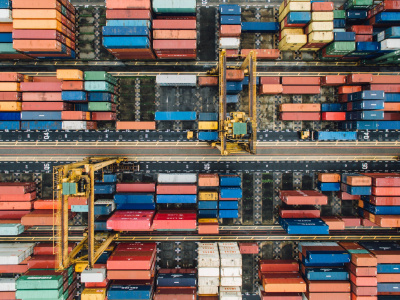
The Right to Trade: A Mechanism for Revitalising Pro-Development WTO Negotiations?
What would it take to revitalise and rebalance the World Trade Organization? Joseph Stiglitz and Andrew Charlton make ambitious and innovative proposals for revitalising and rebalancing the World Trade Organization (WTO) in a recent report The Right to Trade: Rethinking the Aid for Trade Agenda (1). This article sets out to and critically appraises recent ambitious and innovative proposals by Joseph Stiglitz and Andrew Charlton.
Aid for trade: failing to live up to its promises
The reform proposals put forward by Stiglitz and Charlton stem directly from their evaluation of ‘aid for trade’. Since its launch in 2005, ‘Aid for Trade’ has gained a high level of visibility and 25% of all official development assistance is now labelled ‘aid for trade’. While Stiglitz and Charlton accept that ‘aid for trade’ has promoted trade and boosted developing country exports, overall their verdict is a critical one: it has “failed to live up to its promise of additional, predictable and effective finance to support developing countries’ integration into the global economy”.
While the then WTO Director-General Pascal Lamy recently lauded the ‘aid for trade’ initiative for raising more than US$200 billion, Stiglitz and Charlton argue that there is “scant evidence” that this aid is really additional. They point out that there is no rigorous mechanism for monitoring and evaluation (the system relies on self-assessment by donors), making it hard to assess additionality and impact. Moreover, financing may be skewed towards the preferences of donors, which puts it at risk of being “just another form of conditionality”. Overall they contend that ‘aid for trade’ has become a “means for both the aid and trade communities to paper over their weaknesses without doing much for the fundamental concerns of poor countries”.
Enshrining a ‘right to trade’ and a ‘right to development’ in the WTO
Having raised deep concerns about the failure of ‘aid for trade’ Stiglitz and Charlton make ambitious proposals for rebalancing the global trading system. The first pillar of their proposal is to enshrine and enforce a ‘right to trade’ and a ‘right to development’ through the WTO’s dispute settlement mechanism.
The ‘right to trade’ is proposed as a means for addressing the trade barriers facing exporters from developing countries. The ‘right to trade’ would give developing countries the ability to bring an action against an advanced country if “a specific policy materially impedes the development of an identified community in a poor country by restricting their ability to trade”. The complementary ‘right to development’ is a means for addressing the challenges that arise when developing countries implement multilateral trade rules at home. The authors argue that aspects of the existing trade rules can impair development including by impeding industrialisation, limiting developing countries’ access to technology and knowledge, and reducing public budgets. The ‘right to development’ would “limit the applicability of WTO obligations when the enforcement of such obligations would have a significant adverse effect on development”. Alternatively put, it is the “right not to be harmed by the imposition of trade rules”.
The second pillar of their reform proposal is to create a Global Trade Facility, which would fund “genuine aid for trade” and support developing countries to bring cases under the new ‘right to trade’ and ‘right to development’. The Global Trade Facility would not implement ‘aid for trade’ programmes directly but would allocate resources based on proposals from a wide range of development organisations. It would provide robust tracking and assessment and be governed in a way that ensures a high degree of developing country oversight. Channelling funds in this way would make the allocation of funds more transparent, predictable and responsive to developing country needs and would help insulate ‘aid for trade’ finance from the political interests of donor countries.
Stiglitz and Charlton propose that funds be raised from three sources: advanced countries would transfer 0.05% of their GDP (as part of their broader commitment to dedicate 0.7% of GDP to aid); a small fee would be levied on advanced country exports to developing countries (a mechanism for compensating developing countries for tariff revenues foregone as the result of trade liberalisation); and advanced countries would pay the equivalent of 5% of all their agricultural subsidies and 15% of all arms sales.
How feasible are these reforms?
Such bold reform proposals stimulate a series of questions, particularly about the ways that these reforms might be put into practice. Five are highlighted below.
First, what exactly is the scope of the ‘right to trade’ and the ‘right to development’? Stiglitz and Charlton make it clear that the ‘right to trade’ (and presumably the ‘right to development’) would transcend any existing WTO agreements and apply to all trade-related policies of advanced country member states. While they note that these rights would be ‘subject to appropriate safeguards’, they do not set out the types of safeguards that they envisage as limiting the scope of these rights. This leaves many questions unanswered. For instance, how much and what type of harm would have to be caused in order for a developing country to invoke the ‘right to trade’ or the ‘right to development’? On what grounds should an advanced country be able to invoke a safeguard?
Stiglitz and Charlton reject calls for greater specificity, proposing that the rights be enshrined in WTO law at a high level of generality so as to avoid circumvention by developed countries (they are concerned that developed countries will devise policies that are consistent with the letter of the law but against its spirit). Their proposals leave the interpretation of these rights and determination of their scope to the experts appointed to WTO panels in individual dispute cases. Whether or not these experts interpret the rights in the manner Stiglitz and Charlton envisage would depend greatly on the selection of experts and the depth of their expertise on development.
Second, which parties should be granted the right to bring a dispute? One of the most novel aspects of the proposals is to give some private individuals the right to file a dispute. They rightly point out that poor countries may refrain from filing disputes out of fear that they will come under coercive pressure from large countries. To offset these power asymmetries they propose that two other groups be accorded the right to bring a case: groups of developing countries (this is feasible under the current WTO arrangements where countries can be co-complainants), and “any group of poor individuals harmed by the trade policy of another country”.
Providing civil society and citizen groups the right to file WTO dispute cases against states is appealing as it would expand participation and could increase legitimacy. However granting individuals the right to bring cases would fundamentally alter the nature of the WTO, moving it from a purely inter-state to a transnational system of trade governance. Such a move deserves careful reflection, as the ramifications are likely to be substantial. For instance, on what grounds is it justifiable to allow some groups of citizens the right to file a dispute but not others? Why should a group of poor people in an advanced country not have the same right to file a case under the ‘right to trade’ as a group of poor people in a least developed country? An obvious risk of opening up avenues for private actors such as citizen groups to lodge disputes is that powerful private actors, including companies, are also likely to lobby for such rights.
Third, should the ‘right to trade’ and ‘right to development’ only be made available to least-developed or to all developing countries? The authors propose that both rights be made enforceable for least developed countries but that for ‘emerging markets’ a ‘softer’ version might be appropriate, whereby they could ask for a declaratory judgement from the WTO as to whether a given rule is adversely affecting their right to trade or development. While it is the case that advanced industrialised countries are more likely to accept such a two-tier system, it is not clear that this more modest ‘rebalancing’ of the trading system would provide emerging economies with sufficient gains to unlock the negotiating impasse and revitalise WTO negotiations, which is the authors’ aspiration.
Fourth, and related, should least developed countries be able to bring a case against emerging markets for infringing on their ‘right to trade’ and, if so, should emerging markets have the same responsibilities as developed countries to provide redress? The authors are silent on this, but as trade with emerging markets is becoming increasingly important for least developed countries, this question merits further reflection.
A fifth and final question concerns the political viability of the reforms: Why would the key actors in the international trading system (advanced industrialised countries and emerging markets) embrace these reform proposals given that the costs to them could be significant while the gains will accrue almost exclusively to least developed countries?
Conclusion
The reform proposals made by Stiglitz and Charlton are big, bold and a welcome breath of fresh air in the debate about the way forward for the WTO. At a time when vision and momentum in the multilateral trading system is sorely lacking and we are seeing a turn to plurilateral and regional initiatives, Stiglitz and Charlton are right to demand that we engage in serious debate and action on the fundamental aims of the trading system. A next step would be to critically engage key member states, including least developed countries and citizen groups (the intended beneficiaries), and top legal experts in a detailed discussion about the desirability and legal feasibility of enshrining a ‘right to trade’ and a ‘right to development’ in the WTO.
This article is based on E. Jones (2013) The Right to Trade’: A Mechanism for Revitalising Pro-Development WTO Negotiations? Trade Hot Topics, June 2013 London: Commonwealth Secretariat.
Emily Jones is Deputy Director of the Global Economic Governance Programme, University of Oxford.
Footnote
1. Joseph E Stiglitz and Andrew Charlton (2013), The Right to Trade: Rethinking the Aid for Trade Agenda, Commonwealth Secretariat, London.
This article was published in GREAT Insights Volume 2, Issue 8 (November 2013).



